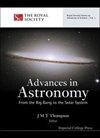Analysis of ∼106 Spiral Galaxies from Four Telescopes Shows Large-Scale Patterns of Asymmetry in Galaxy Spin Directions
IF 1.2
4区 物理与天体物理
Q3 ASTRONOMY & ASTROPHYSICS
引用次数: 6
Abstract
The ability to collect unprecedented amounts of astronomical data has enabled the nomical data has enabled the stu scientific questions that were impractical to study in the pre-information era. This study uses large datasets collected by four different robotic telescopes to profile the large-scale distribution of the spin directions of spiral galaxies. These datasets cover the Northern and Southern hemispheres, in addition to data acquired from space by the Hubble Space Telescope. The data were annotated automatically by a fully symmetric algorithm, as well as manually through a long labor-intensive process, leading to a dataset of nearly 10 6 galaxies. The data show possible patterns of asymmetric distribution of the spin directions, and the patterns agree between the different telescopes. The profiles also agree when using automatic or manual annotation of the galaxies, showing very similar large-scale patterns. Combining all data from all telescopes allows the most comprehensive analysis of its kind to date in terms of both the number of galaxies and the footprint size. The results show a statistically significant profile that is consistent across all telescopes. The instruments used in this study are DECam, HST, SDSS, and Pan-STARRS. The paper also discusses possible sources of bias and analyzes the design of previous work that showed different results. Further research will be required to understand and validate these preliminary observations.从四台望远镜对~ 106个螺旋星系的分析显示了星系自旋方向的大规模不对称模式
收集前所未有数量的天文数据的能力使经济学数据能够解决在前信息时代无法研究的科学问题。这项研究使用四台不同的机器人望远镜收集的大型数据集来描绘螺旋星系自旋方向的大规模分布。除了哈勃太空望远镜从太空获取的数据外,这些数据集还覆盖了南北半球。这些数据由完全对称的算法自动注释,并通过漫长的劳动密集型过程手动注释,形成了近106个星系的数据集。数据显示了自旋方向不对称分布的可能模式,并且不同望远镜之间的模式一致。当使用星系的自动或手动注释时,这些轮廓也一致,显示出非常相似的大尺度模式。结合所有望远镜的所有数据,可以对星系数量和足迹大小进行迄今为止最全面的分析。这些结果显示了一个统计上显著的轮廓,在所有望远镜中都是一致的。本研究中使用的仪器有DECam、HST、SDSS和Pan STARRS。文章还讨论了偏差的可能来源,并分析了先前工作中显示不同结果的设计。需要进一步的研究来理解和验证这些初步观察结果。
本文章由计算机程序翻译,如有差异,请以英文原文为准。
求助全文
约1分钟内获得全文
求助全文
来源期刊

Advances in Astronomy
ASTRONOMY & ASTROPHYSICS-
CiteScore
2.70
自引率
7.10%
发文量
10
审稿时长
22 weeks
期刊介绍:
Advances in Astronomy publishes articles in all areas of astronomy, astrophysics, and cosmology. The journal accepts both observational and theoretical investigations into celestial objects and the wider universe, as well as the reports of new methods and instrumentation for their study.
 求助内容:
求助内容: 应助结果提醒方式:
应助结果提醒方式:


